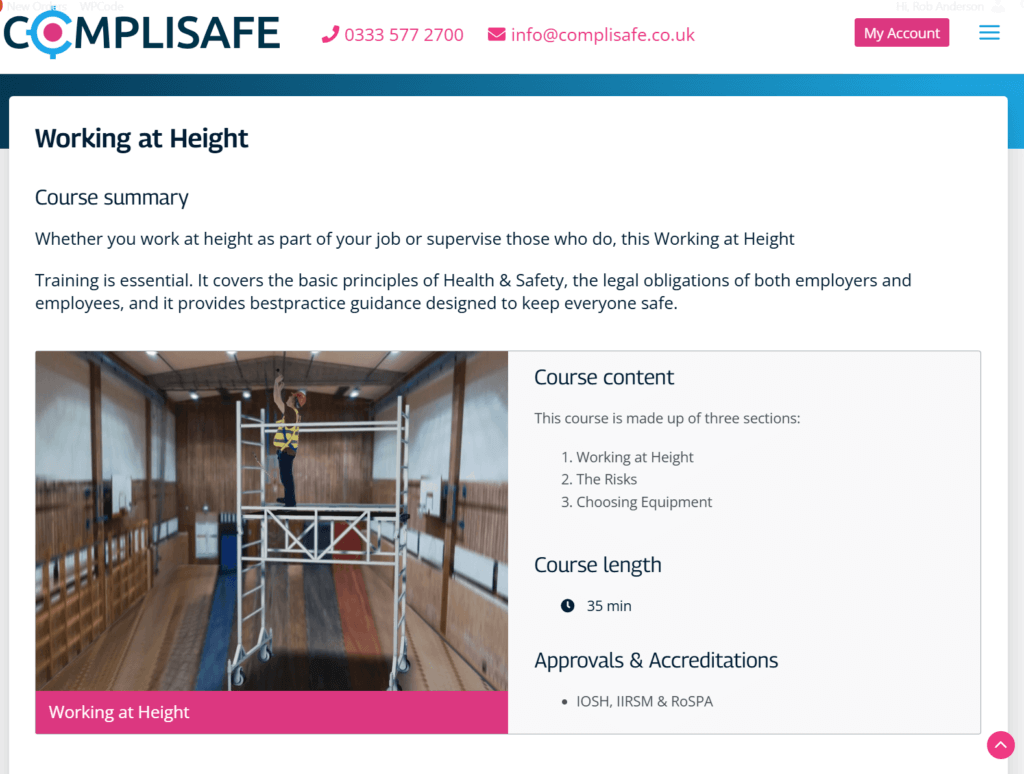Employers and those in control of work at height must first assess the risks.
Before working at height you must follow these simple steps:
- avoid work at height where it is reasonably practicable to do so
- where work at height cannot be easily avoided, prevent falls using either an existing place of work that is already safe or the right type of equipment
- minimise the distance and consequences of a fall, by using the right type of equipment where the risk cannot be eliminated
You should:
- do as much work as possible from the ground
- ensure workers can get safely to and from where they work at height
- ensure equipment is suitable, stable and strong enough for the job, maintained and checked regularly
- not overload or overreach when working at height
- take precautions when working on or near fragile surfaces
- provide protection from falling objects
- consider emergency evacuation and rescue procedures
How to check your ladder is safe before you use it
Before using a ladder, you should have access to user instructions from the manufacturer in case you need to refer to them.
You should always carry out a ‘pre-use’ check to spot any obvious visual defects to make sure the ladder is safe to use.
A pre-use check should be carried out:
- by the person using the ladder
- at the beginning of the working day
- after something has changed, eg a ladder has been dropped or moved from a dirty area to a clean area (check the state or condition of the feet)
The check should include:
- the stiles – make sure they are not bent or damaged, as the ladder could buckle or collapse
- the feet – if they are missing, worn or damaged the ladder could slip. Also check the ladder feet when moving from soft/dirty ground (eg dug soil, loose sand/stone, a dirty workshop) to a smooth, solid surface (eg paving slabs), to make sure the actual feet and not the dirt (eg soil, chippings or embedded stones) are making contact with the ground
- the rungs – if they are bent, worn, missing or loose, the ladder could fail
- any locking mechanism – does the mechanism work properly? Are components or fixings bent, worn or damaged? If so, the ladder could collapse. Ensure any locking bars are fully engaged
- the stepladder platform – if it is split or buckled, the ladder could become unstable or collapse
- the steps or treads on stepladders – if they are contaminated, they could be slippery; if the fixings are loose on the steps, they could collapse
If you spot any of the above defects, do not use the ladder and tell the person in charge of the work.
Stepladders
When using a stepladder to carry out a task:
- Check all four stepladder feet are in contact with the ground and the steps are level
- Only carry light materials and tools
- Don’t overreach
- Don’t stand and work on the top three steps (including a step forming the very top of the stepladder) unless there is a suitable handhold
- Ensure any locking devices are engaged
- Try to position the stepladder to face the work activity and not side on. However, there are occasions when a risk assessment may show it is safer to work side on, eg in a retail stock room when you can’t engage the stepladder locks to work face on because of space restraints in narrow aisles, but you can fully lock it to work side on
- Try to avoid work that imposes a side loading, such as side-on drilling through solid materials (eg bricks or concrete)
- Where side loadings cannot be avoided, you should prevent the steps from tipping over, eg by tying the steps. Otherwise, use a more suitable type of access equipment
- Maintain three points of contact at the working position. This means two feet and one hand, or when both hands need to be free for a brief period, two feet and the body supported by the stepladder
When deciding whether it is safe to carry out a particular task on a stepladder where you cannot maintain a handhold (eg to put a box on a shelf, hang wallpaper, or install a smoke detector on a ceiling), the decision needs to be justified, taking into account:
- the height of the task
- whether a handhold is still available to steady yourself before and after the task
- whether it is light work
- whether it avoids side loading
- whether it avoids overreaching
- whether the stepladder can be tied (eg when side-on working)
Recommended guidance

Recommended Training

